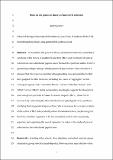Files in this item
More on the genetical theory of multilevel selection
Item metadata
| dc.contributor.author | Gardner, Andy | |
| dc.date.accessioned | 2016-08-12T23:33:18Z | |
| dc.date.available | 2016-08-12T23:33:18Z | |
| dc.date.issued | 2015 | |
| dc.identifier | 197927582 | |
| dc.identifier | 170394d1-fcae-40c8-8b33-e3e4fc564bc3 | |
| dc.identifier | 84941600610 | |
| dc.identifier | 000362591200014 | |
| dc.identifier.citation | Gardner , A 2015 , ' More on the genetical theory of multilevel selection ' , Journal of Evolutionary Biology , vol. Early view . https://doi.org/10.1111/jeb.12684 | en |
| dc.identifier.issn | 1010-061X | |
| dc.identifier.uri | https://hdl.handle.net/10023/9295 | |
| dc.description | This study was supported by a Natural Environment Research Council Independent Research Fellowship (NE/K009524/1). | en |
| dc.description.abstract | In my article The genetical theory of multilevel selection, I provided a synthesis of the theory of multilevel selection (MLS) and the theory of natural selection in class-structured populations. I framed this synthesis within Fisher’s genetical paradigm, taking a strictly genetical approach to traits and fitness. I showed that this resolves a number of longstanding conceptual problems that have plagued the MLS literature, including the issues of “aggregate” versus “emergent” group traits, “collective-fitness1” versus “collective-fitness2” and “MLS1” versus “MLS2”. In his commentary, Goodnight suggests this theoretical and conceptual synthesis is flawed in several respects. Here, I show this is incorrect, by: reiterating the theoretical and conceptual goals of my synthesis; clarifying that my genetical approach to traits is necessary for a proper analysis of the action of MLS independently of non-Darwinian factors; emphasising that the Price-Hamilton approach to MLS is consistent, useful and conceptually superior; and explaining the role of reproductive value in the study of natural selection in class-structured populations. | |
| dc.format.extent | 134866 | |
| dc.language.iso | eng | |
| dc.relation.ispartof | Journal of Evolutionary Biology | en |
| dc.subject | Breeding value | en |
| dc.subject | Cancer | en |
| dc.subject | Class structure | en |
| dc.subject | Contextual analysis | en |
| dc.subject | Group adaptation | en |
| dc.subject | Group selection | en |
| dc.subject | Haplodiploidy | en |
| dc.subject | Price equation | en |
| dc.subject | Reproductive value | en |
| dc.subject | QH301 Biology | en |
| dc.subject | SDG 3 - Good Health and Well-being | en |
| dc.subject.lcc | QH301 | en |
| dc.title | More on the genetical theory of multilevel selection | en |
| dc.type | Journal item | en |
| dc.contributor.sponsor | NERC | en |
| dc.contributor.institution | University of St Andrews. School of Biology | en |
| dc.contributor.institution | University of St Andrews. Centre for Biological Diversity | en |
| dc.identifier.doi | 10.1111/jeb.12684 | |
| dc.description.status | Peer reviewed | en |
| dc.date.embargoedUntil | 2016-08-12 | |
| dc.identifier.grantnumber | NE/K009524/1 | en |
This item appears in the following Collection(s)
Items in the St Andrews Research Repository are protected by copyright, with all rights reserved, unless otherwise indicated.

